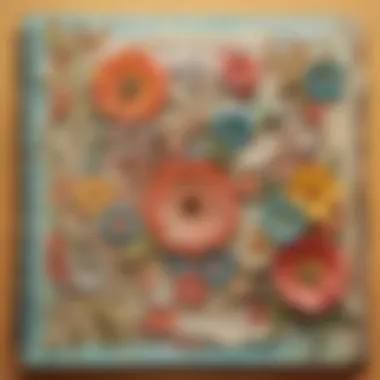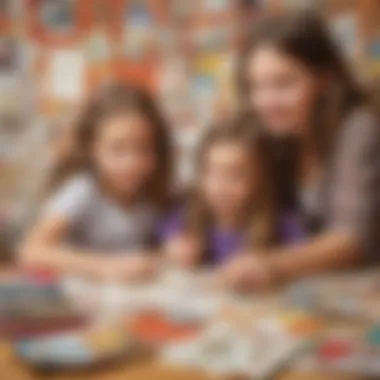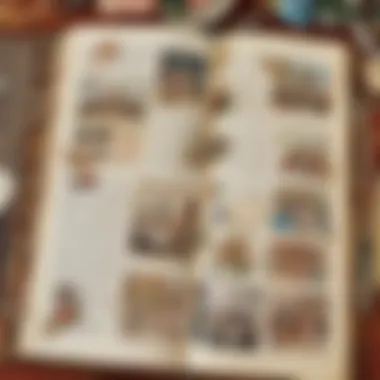Crafting Meaningful Yearly Scrapbooks for All


Intro
Creating a yearly scrapbook serves as a profound tapestry that weaves together the threads of our life’s moments. It is more than just a collection of images and phrases; it embodies the essence of treasured memories, allowing us to reflect on the time gone by and the experiences we have encountered along the way.
In a world dominated by digital snapshots, the practice of compiling a scrapbook feels increasingly nostalgic yet relevant. Each scrapbook is a personal narrative, capturing the details of events, relationships, and milestones, infusing them with creativity and affection. It’s an activity that resonates across generations, making it suitable for both kids and adults alike. Parents can engage their children in this art, enhancing their cognitive growth while also fostering family bonding.
This guide dives deep into the craft of creating a yearly scrapbook. We will explore a variety of creative materials, thematic organization strategies, and fun techniques that can make the process enjoyable for everyone involved. From selecting the right supplies to arranging pages that convey a cohesive story, there's a wealth of insights to glean. By the end of our journey through this guide, you will be equipped with the know-how to turn your life experiences into beautiful keepsakes that can be cherished for the years ahead.
Understanding the Concept of a Yearly Scrapbook
Creating a yearly scrapbook is an engaging activity that bridges the gap between memory preservation and artistic expression. It allows individuals and families to capture the significant moments of their lives throughout a year in a creative and meaningful way. This act goes beyond simply collecting photos; it’s about weaving a narrative that recounts adventures, achievements, and those quiet moments that often get lost in time.
Definition of a Yearly Scrapbook
A yearly scrapbook can be defined as a personalized collection of printed photographs, memorabilia, and artistic embellishments that commemorate events and experiences from the past year. It offers a tangible way to document life’s journey, providing a glimpse into personal growth and family dynamics over time. This scrapbook transforms the everyday into something extraordinary by showcasing not just images, but stories, reflections, and emotions.
Importance of Documenting Memories
Preserving Family History
Preserving family history stands out as a vital aspect of scrapbooking. When families take the time to document their travels, milestones, and daily life, they create a visual account that can be passed down to future generations. It is a tangible legacy that connects family members to their roots, encouraging younger generations to learn about their heritage. Furthermore, capturing these unique moments ensures that the essence of who you are as a family is not diluted over time. The key characteristic of this process is its ability to serve as a historical record, which can be beneficial to both current and future family members. By incorporating diverse elements like letters, postcards, and family recipes, scrapbooks become rich narratives steeped in personal tradition.
The Emotional Value of Memories
On another note, the emotional value of memories cannot be understated. Memories play a pivotal role in defining our identities and fostering emotional connections among family members. Crafts like scrapbooking allow individuals to express their sentiments creatively, bridging emotive experiences through pictures and words. The scrapbook becomes a vessel for nostalgia, laughter, and sometimes, even tears. Integrating a heartfelt note or a special quote can turn a simple image into a profound reflection of feelings. It’s not merely about preserving moments but also about fostering a collective memory that can be revisited for years to come.
The Evolution of Scrapbooking
Historical Context
Understanding the historical context of scrapbooking reveals how significantly this craft has evolved over centuries. Historically, scrapbooking can trace its roots back to the 15th century when individuals began creating "commonplace books" as a way to compile personal writings, poems, and sketches. These early forms were not just repositories of information, but a reflection of one’s intellectual pursuits and social connections. While the materials and methods have dramatically changed, the core intent of preserving personal narratives remains consistent. Acknowledging this backdrop not only enriches the scrapbooking experience but also instills a deeper appreciation for the art form itself and its roots in human expression.
Modern Trends in Scrapbooking
Fast forward to today, and modern scrapbooking has embraced both technology and creativity in a myriad of ways. Digital scrapbooking has surged in popularity, allowing for intricate designs and collaborations that were once only possible with physical materials. Tools like Canva and Photoshop provide new mediums and a wider range of creative expression. However, traditional methods still hold appeal for many, offering tactile engagement that digital formats sometimes lack. For many, choosing which method to use often boils down to personal preference, time constraints, and access to materials. Emphasizing versatility makes modern scrapbooking accessible to anyone, regardless of skill or experience level.
"Memory is the treasure house of the mind wherein the monuments thereof are kept and preserved." - Thomas Fuller
By dissecting these fundamental aspects of yearly scrapbooking, individuals can appreciate its significance. It's not just about throwing together photos; it's about crafting meaningful narratives. This understanding lays the groundwork for a fulfilling scrapbooking journey.
Materials Needed for Scrapbooking
As any seasoned scrapbooker will tell you, the right materials are the backbone of your creative endeavors. When you dive into the project of creating a yearly scrapbook, having a well-thought-out collection of supplies can streamline the process and enhance the outcome.
More than just decorative items, these materials serve a fundamental role in holistically capturing memories and experiences. Each piece helps tell the story of your year, making the scrapbook not just a collection of photos but a vivid representation of your life events.
Essential Supplies
Paper Types
When it comes to paper types, you can't skimp on quality. The right paper can make a world of difference in how your scrapbook looks and feels. Acid-free paper, for instance, is a popular choice for many scrapbookers because it won't cause your photos to fade or discolor over time.
Using textured paper adds depth and dimension to your pages. It allows for tactile experiences beyond just visuals, which can be particularly engaging for children involved in the process. However, not all paper reacts the same to adhesives, so it’s crucial to test before you start sticking things down.
A unique feature of heavier cardstock is that it can serve as a sturdy base for layering. While it’s durable, its weight can also limit how much you want to bulk up a page. In the end, a balance is key.
Adhesives and Tools
Adhesives and tools are your glue—quite literally! One of the most commonly used types of adhesive is double-sided tape. It's straightforward to use and provides a clean look. Glue sticks are also popular among kids due to their ease of application. However, the downside of glue sticks is that they can dry up quickly if not used frequently.
Beyond these, liquid adhesives can create strong bonds but may pose challenges for younger scrapbookers, as they can get messy.
Tools like scissors, corner rounders, or paper trimmers are indispensable in creating that polished look. A good quality cutting mat can protect your surfaces and keep your tools in good shape. Having the right tools saves time and reduces frustration, enhancing the overall experience of scrapbooking.
Creative Add-Ons
Stickers and Embellishments
Stickers and embellishments jazz things up! These little extras can turn a simple page into a vibrant piece of art. Character and theme stickers are especially appealing for children, who often gravitate towards visuals and familiar icons.
These elements allow for personalization. You can dictate the mood of a page based on the stickers used, whether it’s a whimsical approach or a more elegant design. One potential downside could be overuse; it's easy to go overboard and crowd a page.
One might say that stickers give you the ability to express yourself without needing an art degree, which is a key selling point in the large canvas of scrapbooking.
Specialty Papers
Specialty papers can elevate your scrapbook in ways you might not initially consider. These papers come in various textures and finishes—think glitter papers or metallic surfaces. The sheer uniqueness of specialty papers can make certain experiences stand out significantly.
One characteristic of these papers is their ability to catch light and reflect different hues, adding a visual richness to your pages. They can often carry a memory or theme that resonates more significantly than a standard print could.
However, they are generally pricier than standard papers, and their distinct properties may not work with all adhesives. You may wish to reserve these papers for milestones or significant events, ensuring their added value lives up to the investment.
Technological Tools
Digital Scrapbooking Software
In the age of technology, digital scrapbooking software offers a fresh take on traditional methods. Programs like Adobe Photoshop Elements or apps such as Canva let you craft layouts, manipulate images, and organize your content digitally.
The key advantage here is versatility. You can experiment with endless design options without the mess. If you make a mistake? Just hit undo! This aspect is particularly appealing to those who prefer a more structured approach to creativity. However, it removes the tactile engagement that many find essential in scrapbooking.
Printing Services for Photos
Many printing services today offer options that make it easy to get high-quality images right at your fingertips. Services like Snapfish or Shutterfly can print a range of sizes and finishes.
What’s attractive about these options is the quality of the prints. You typically get richer colors and sharper images than standard home printers can deliver. This is vital if you're incorporating family portraits or vacation snapshots that are meant to be cherished.
On the flip side, waiting for the prints can feel tedious, especially if you're eager to put everything together. Plus, costs can add up if you’re printing a lot of pictures.


"Scrapbooking is not just a hobby; it’s a way to relive and celebrate the moments that shape us, using both traditional and innovative materials."
With the materials identified, it’s evident that thoughtful selection can significantly shape how your yearly scrapbook turns out. Each item acts not only as a tool but as a vehicle for storytelling, making the memories you preserve—be they lighthearted or solemn—intensely significant.
Themes for Your Yearly Scrapbook
When crafting a yearly scrapbook, the choice of theme is paramount. It’s not just about sticking in pictures or jotting down notes; it’s about telling a story, capturing moments, and honoring experiences that shape our lives. A well-chosen theme weaves a narrative fabric that resonates not just with the creator but also with family and friends who take part in the reflection.
Benefits of Thematic Scrapbooks
- Cohesion: A single theme unites different memories, making it easier for viewers to follow the tale.
- Focus on Significant Events: It encourages the documentation of events that hold meaning, enhancing the emotional connection.
- Creative Expression: Themed scrapbooks offer a platform for creativity to flourish—whether through color schemes, decorative elements, or narrative styles.
A scrapbook without a theme is like a novel without a plot; there’s all sorts of chaos with little to connect the dots.
Personal Milestones
Birthdays and Anniversaries
Focusing on birthdays and anniversaries provides a foundation filled with joy and nostalgia. These milestones mark personal growth and the evolution of relationships. Birthdays come with celebrations that spark laughter and festivities, while anniversaries reflect on the paths traveled together.
It creates a celebratory atmosphere and ensures cherished moments don’t fade with time. A scrapbook celebrating these occasions captures not just the event but also the emotions tied to them. This makes it a popular choice; the snapshots and notes of anticipation and happiness are relatable for all, yet distinct to each family.
Unique to birthdays and anniversaries is the opportunity for various elements to shine: photographs of cake cutting, messages from loved ones, and, perhaps, a few silly party hats to represent laughter. However, the challenge lies in consistently making each year unique, ensuring the scrapbook evades monotony.
Travel Experiences
Travel experiences present another rich theme worthy of exploration. Travel can transform a simple moment into an adventure filled with anecdotes. Each trip—whether a short excursion or a long journey—opens up new vistas and encounters. They provide a backdrop to record diverse cultures, landscapes, and personal experiences that broaden horizons.
The essence of travel is not merely in the destination but also in the stories shared with family and friends along the way. Thus, incorporating travel experiences within a scrapbook invites the creator to curate narratives that excite and inspire. Photographs of breathtaking sunsets, postcards from quaint towns, and even a sand sample from a beach trip can add a tactile element to the storytelling.
However, this can sometimes shift into an overwhelming process, given the vast number of memories that could be captured. It is essential to strike a balance and select highlights that resonate deeply, ensuring each chosen experience enhances the overall narrative.
Seasonal Themes
Spring Adventures
Spring is often synonymous with renewal and rebirth, making it an ideal theme for capturing adventurous outings. This season invites us to enjoy outdoor activities — from hiking in blossoming nature to picnics under more sunny skies. Integrating spring adventures into the scrapbook allows for a vivid montage of bright colors and lively photos, supplemented by notes describing the wonder of blooming flowers or the feeling of cool grass beneath one’s feet.
Notably, spring adventures can also symbolize hope and growth, making it a beneficial choice as it offers a refreshing perspective to families. However, planning can be tricky given the unpredictable weather; keeping a lookout for rainy surprises is part of the adventure.
Winter Celebrations
As the thermometer dips, winter emerges, rich with traditions and warmth. Winter celebrations—whether it’s cozying up for the holidays, celebrating New Year’s, or participating in local traditions—offer unique opportunities to harness photographs and memorabilia in the scrapbook.
Highlighting the spirit of giving, the twinkling lights, and snowy landscapes, this theme allows families to reflect on cherished moments spent together. Moreover, it facilitates discussions on warmth and togetherness in contrast to the cold outside.
A potential drawback is a tendency to lean heavily into repetition; many families celebrate similar customs year after year. Mixing it up with unique anecdotes or recent experiences can help keep this theme lively.
Family Activities
Outdoor Events
Family events often become cornerstones of scrapbooks as they bring everyone together, whether through sports days or community picnics. These gatherings mark moments of connection that are worth cherishing. Outdoor events breathe life into the scrapbook, blending candid moments with laughter-driven memories.
This theme not only enriches the narrative but also can spotlight the importance of nature in family bonding. However, capturing each family member’s perspective can be challenging, as it’s easy to overlook quieter moments amidst the excitement of a bustling event.
Volunteering Experiences
Choosing to document volunteering experiences embeds a theme of altruism and community spirit into your scrapbook. Engaging with local causes fosters relationships, awareness, and personal growth, which translates beautifully into storytelling.
Highlighting volunteering can reflect a family's values and the lessons learned along the way, as it's often a collaborative effort. Sharing these experiences provides children with perspectives that extend beyond their immediate environment.
On the flip side, it may sometimes feel like these moments get lost amidst the more festivity-filled themes. Nevertheless, including a few heartfelt snapshots and reflections can assure they remain part of the family’s journey.
In summary, selecting themes for a yearly scrapbook is akin to choosing colors for a painting; it shapes the narrative, creates connections, and helps create a lasting legacy.
Organizing Your Scrapbook Content
When it comes to scrapbooking, organization is the name of the game. A well-organized scrapbook not only showcases memories beautifully but also promotes a deeper appreciation for the moments captured within its pages. It’s like telling a story, where the arrangement of chapters can significantly affect how the tale is perceived. With thoughtful organization, you can help the viewer navigate through time and themes, making the experience engaging and layered.
Chronological Arrangement
A chronological arrangement is simplicity in itself. By following the timeline of events, you guide the viewer through your life journey, showcasing changes, growth, and milestones. Think of it as a visual diary; you start with January memories and work your way to December.
Benefits include:
- Ease of tracking: It reminds you of exactly when things happened, like a photo album, but with added flair.
- Natural progression: Transitions from one event to another feel fluid, giving a nice flow.
However, keeping to a strict timeline can sometimes feel limiting. There’s always the chance that a spontaneous trip or sudden event may not fit neatly into a month, so a little flexibility can also help.
Thematic Grouping
If chronological arrangement feels a bit too rigid, you might consider thematic grouping. This involves clustering your memories around specific themes, like vacations, birthdays, or family traditions. By organizing content thematically, you can create visual ‘chapters’ that resonate with emotions and experiences.
Thematic grouping allows for:
- Creative expression: It opens a door for artful layouts, colors, and designs specific to a theme.
- Focused storytelling: Each theme highlights a different aspect of life, making it easy for viewers to connect emotionally.
On the flip side, thematic organization may require more planning upfront as you decide what themes to include, possibly leading to an initial overwhelm.
Mixing Formats
Photos vs. Text
When you’re crafting your scrapbook, the balance between photos and text is crucial. Photos are often worth a thousand words, but adding text can give context, emotions, or anecdotes that images alone might not convey.
Key characteristics of photos vs. text include:
- Visual storytelling: Photos provide immediate visual stimulation that can capture a viewer’s interest faster than plain text.
- Narrative depth: Text adds layers, capturing thoughts and feelings that simply look good on a page.


Both mediums shine in their own way, yet relying too heavily on one can diminish the overall effect. Too many photos without any text can create a gallery feel, while pages filled only with text may lose the viewer’s interest.
Integrated Artwork
Integrated artwork is another avenue for creative expression that can enhance visual appeal in your scrapbook. This can include doodles, sketches, stickers, or even child-made artworks. This element creates a lively and personalized touch that photos and text alone might not provide.
Unique features include:
- Originality: Each scrapbook becomes a unique piece of art, reflecting the creativity of the creator.
- Engagement: Viewers might feel more engaged with pages that invite them to explore beyond traditional photo frames.
However, while integrated artwork can enrich your scrapbook, it can also lead to a visually cluttered page if not done thoughtfully. Striking a balance between aesthetic and organization is key to keeping the viewer’s focus intact.
"Good organization in a scrapbook allows it to transform from a simple collection of images and mementos into a cherished narrative that resonates with both creators and viewers."
Ultimately, taking the time to think about how to organize your scrapbook content ensures that the memories reflected within remain accessible, relatable, and truly meaningful throughout the years.
Techniques to Enhance Your Scrapbook
Creating a yearly scrapbook is not just about pasting pictures and memories. It's about breathing life into those memories through creative expression. Techniques to enhance your scrapbook help elevate your storytelling, making your treasured moments visually appealing and engaging. With a few simple methods, you can create something truly special that can be proud to showcase, while providing a wonderful experience for everyone involved, particularly kids who get to watch their own creativity flourish.
Photographic Techniques
Lighting and Composition
Lighting and composition are like the bread and butter of photography. Getting these right can make a world of difference in the overall look of your scrapbook pages. Good lighting adds clarity, depth, and interest to photographs, making even the simplest image stand out. Whether it's natural light streaming through a window or soft artificial lighting, ensuring your photos are well-lit can give them a polished feel.
A key characteristic of this technique is its ability to influence mood. Soft, natural light may evoke a sense of warmth and nostalgia, while dimmer settings can create an intimate ambiance. This aspect becomes particularly useful in a scrapbook, where emotions are intertwined with each photograph. However, it's crucial to be mindful of shadows; harsh light can lead to unflattering results and distract from the main subject.
The unique feature of composition lies in framing images correctly. Techniques such as the rule of thirds can help draw attention to focal points within the picture. A harmonious arrangement not only enhances the visual vibe but also stimulates storytelling, guiding the viewer through your memories with ease. Still, be careful; overly complex compositions might muddy the simplicity of cherished moments.
Editing Basics
Editing basics play a pivotal role in turning good photographs into great ones. Editing not only helps in correcting light and colors but also injects vibrancy into dull images, making them burst with life. This technique is such a popular choice among scrapbookers, as it embodies the chance to bring out the emotions within each capture.
One of the key characteristics of editing is the ability to enhance the context of images. Whether you choose to adjust brightness levels or increase contrast, these minor tweaks can create a significant impact. It also allows you to play with filters, adding that extra flair that can complement your scrapbook’s theme.
Editing programs offer unique features, such as cropping and special effects, to create a cohesive look throughout your scrapbook. However, it’s wise to tread lightly; going overboard with edits can turn beautiful photos into artificial caricatures. Aim for enhancement rather than transformation to maintain authenticity in your memories.
Artistic Elements
Illustrations and Drawings
Illustrations and drawings provide an artistic flair that can effectively personalize your scrapbook. Integrating hand-drawn elements adds a unique layer of creativity, making each page feel individualized. This technique allows for expression through abstract art or detailed sketches, lending a special touch to the memories you’re preserving.
A key characteristic of illustrations is their versatility. You can draw anything from whimsical designs to themed motifs that resonate with the content of the pages. This artistic diversity makes illustrations a favored choice for scrapbook enthusiasts, as they can reflect personality and sentiment simultaneously.
On the other hand, the unique feature of illustrations is that they can bridge gaps where photographs may fall short—like expressing feelings or narrating a tale. Just be aware that if someone isn't skilled at drawing, it might feel frustrating rather than fun, leading to adamant edits or abandonment of the art altogether.
Handwritten Notes
Handwritten notes are one of the easiest ways to infuse a personal touch into any scrapbook. They transform ordinary pages into something genuine. Writing captions, anecdotes, or thoughts allows for deeper connections to the memories you’re documenting.
The key characteristic of handwritten notes is their emotional depth. A personal message in your own handwriting gives readers an authentic glimpse into your thoughts—a characteristic that typed text simply can't match. It's these intimate touches that often resonate the most with family and friends when reminiscing.
However, the unique feature of this technique is its potential for imperfection. Misspellings and uneven handwriting may appear to some as flaws, but to others, they weave a genuine narrative that feels approachable and loved. Just make sure that if clarity is a priority, legible writing is a must.
Interactive Components
Pocket Pages
Pocket pages are a clever way to introduce interactivity into your scrapbook. They serve as mini-storages for additional photos, notes, or memorabilia, encouraging readers to engage more closely with each section. This aspect of scrapbooking greatly enhances the overall experience, allowing for a more dynamic presentation of memories.
A standout characteristic of pocket pages is their flexibility. You can easily swap in and out elements, making them a popular choice for those who like to rearrange or curate content over time. They can accommodate various sizes of photographs and materials, affording room for creativity and spontaneity.
The unique feature of pocket pages is how they transform your scrapbook into not just a visual but also a tactile experience. Having the ability to pull out or add elements makes it feel like a storybook, unfolding memories layer by layer. However, a word of caution—stuffing pockets too full can lead to wear and tear, minimizing their longevity.
Flip-Out Elements
Flip-out elements create an element of surprise in a scrapbook. They allow hidden notes, extra pictures, or comments to be discovered, adding an exciting twist when flipping through the pages. This interactive aspect can enthrall children, making them anticipate what lies in wait.
The key characteristic of flip-out elements is their playful nature. They inject enthusiasm into what might otherwise be a straightforward page. This fun component appeals greatly in family scrapbooks, where such delight can contribute to togetherness and enjoyment.
The unique feature lies in how versatile they can be—from simple fold-outs to complex pop-up designs. However, crafting flips can be tricky; they require precision to ensure they operate well while maintaining structural integrity, as poorly made elements could disrupt the fluidity of the scrapbook.
In summary, the techniques discussed here not only amplify the aesthetic appeal of your scrapbook but also transform the entire process into a deeply engaging and memorable undertaking. By weaving in different photographic techniques, artistic elements, and interactive components, you create a celebration of life—one that’s colorful, personal, and expertly crafted to stand the test of time.
Involving Children in the Scrapbooking Process
Involving children in the scrapbooking process is more than just a fun activity; it represents an opportunity to forge deeper connections within families and foster creativity. Engaging kids in this artistic endeavor doesn’t just keep them busy; it teaches them the value of memories, story-telling, and expression. By participating in scrapbook creation, children not only take pride in their contributions but also learn to appreciate the art of nostalgia, ultimately shaping them into more thoughtful individuals.
Inspiring Creativity
Choosing Themes Together
Choosing themes together can be immensely beneficial in the scrapbook process. It opens the door for children to express their individual interests while also considering the family’s shared experiences. Notably, when kids have a say in the theme, it fosters a sense of ownership. One unique feature of this collaboration is the chance for parents to tap into their child’s current fascinations — be it superheroes, nature, or family trips.
Pros:
- Creates excitement and anticipation.
- Strengthens communication within the family.
Cons:
- Sometimes it can lead to disagreements if preferences clash.
Overall, choosing themes together is a joyful bonding experience that encourages open dialogue among family members.
Creative Freedom in Design


Allowing children creative freedom in design during scrapbooking can transform the experience from mundane to magical. When kids are free to pick colors, stickers, and layouts, they unleash their imagination. This autonomy allows their personalities to shine through, making the scrapbook a true reflection of their ideas. Moreover, it teaches them that there’s no one “right” way to create art, which can positively influence their overall artistic development.
Pros:
- Fosters unique, one-of-a-kind creations.
- Encourages personal expression and individual ideas.
Cons:
- Some children may feel overwhelmed by too many choices.
Creative freedom, despite its potential challenges, often leads to delightful results that can be cherished for years.
Educational Benefits
Developing Fine Motor Skills
Engaging in scrapbook-making can significantly assist in developing fine motor skills among children. The act of cutting, gluing, and arranging items requires dexterity and precision, helping younger kids refine their movements. This process is a natural way to hone skills that are applicable beyond arts and crafts, including writing and other daily tasks. Hence, incorporating scrapbooking as a learning tool can be both fun and educational.
Pros:
- Enhances hand-eye coordination.
- Encourages focus and patience.
Cons:
- Requires adult supervision to ensure safety with tools.
In this light, scrapbooking becomes an exciting means for kids to gain essential skills while enjoying themselves.
Enhancing Storytelling Abilities
Scrapbooking inherently involves storytelling, whether it’s through images, captions, or illustrations. This activity encourages children to articulate their thoughts and memories creatively. By prompting kids to describe their favorite moments or express their thoughts about various themes, scrapbooking nurtures their narrative skills. This skill is invaluable not just in writing but in communicating effectively in general.
Pros:
- Develops coherent narrative skills.
- Boosts vocabulary and expressive language.
Cons:
- Some kids might feel pressured to perform when sharing their stories.
Thus, the storytelling aspect of scrapbooking can enrich children’s ability to convey meaning and emotion, which is vital throughout their educational journey.
Promoting Family Bonding
Shared Activities
Doing scrapbooking as a shared activity is a wonderful way to bring family members closer together. When parents and children collaborate on this project, they get to share memories and create new ones simultaneously. The act of working together on something tangible solidifies unity and creates lasting ties that can strengthen family memories.
Pros:
- Reinforces teamwork and cooperation.
- Builds a sense of belonging within the family.
Cons:
- Time-consuming, which may not suit all families.
Ultimately, shared activities like scrapbooking serve to bridge generational gaps, highlighting collective experiences and personal sentiments.
Creating Lasting Memories
Finally, the essence of scrapbooking lies in creating lasting memories. This project turns ephemeral moments into something permanent, a tangible representation of love and shared history. Every page turned in a scrapbook conveys a story or a special event, safeguarding these memories for future generations. The delightful part is that children not only live these moments but also recognize their importance by preserving them.
Pros:
- Provides a visual family timeline.
- Encourages appreciation of family heritage.
Cons:
- If not maintained, these memories might fade over time.
In the context of family bonding, creating lasting memories through scrapbooking becomes more than a keepsake; it's a .living legacy that can be physically revisited and cherished.
Preserving Completed Scrapbooks
Preserving completed scrapbooks is not just about keeping them safe; it’s a commitment to safeguarding memories for future generations. In our fast-paced world, we often forget that these scrapbooks hold a treasure trove of moments—be it a child’s first drawing or snapshots from a family vacation. The essence of preserving these tomes lies in recognizing their emotional weight. A scrapbook isn't merely a collection of photos and artifacts; each page tells a story, reflecting the joys, trials, and milestones of life.
When we take the time to preserve these volumes, we ensure that the vessels of our memories remain intact, allowing them to be shared with loved ones for years to come. From the nostalgic glance at a wedding photo to the giggles elicited by an old birthday celebration shot, these preserved works bring the past to life in ways that digital images alone might not. Therefore, understanding the nuances of storage and preservation is paramount for anyone serious about scrapbook creating.
Proper Storage Techniques
Using Archival Materials
Using archival materials is a cornerstone of scrapbook preservation. These materials are specifically engineered to resist deterioration over time, ensuring that your scrapbook stands the test of years. When we talk about archival quality, we refer to materials that are acid-free, lignin-free, and chemically stable. These characteristics are vital; otherwise, the acidity in standard paper could lead to yellowing and degradation.
The unique feature here is that archival materials, often available in various forms like paper, adhesives, and storage boxes, provide a solid layer of protection against environmental factors. This means that the corners of your photographs will not fray, and the colors won't fade like they do in regular albums. One of the downsides is that they can be pricier, but consider it an investment in your memories.
Safe Display Options
Safe display options are just as crucial as proper storage. It's about showcasing your documents and photos without exposing them to elements like sunlight, moisture, or dust. Many enthusiasts opt for display frames made of UV-resistant glass that not only enhances the visual appeal but also protects your scrapbook from harmful rays.
The key characteristic of these display options is their balance between aesthetics and preservation. You can beautifully exhibit pages without compromising their condition. A downside might be the limited ability to flip through or handle them frequently, but this is often a wise trade-off for long-term preservation.
Digital Preservation
Scanning and Digitization
Scanning and digitization bring scrapbooking into the digital age. Instead of merely relying on physical storage, turning your completed scrapbooks into digital formats allows for easier sharing and replicating. Scanning ensures that all elements—photos, drawings, and text—are captured in high resolution, preserving the essence of each page.
The beauty of digitization lies in its accessibility. Once converted, you can effortlessly share your scrapbook through social media or store it in the cloud as a backup. However, even though this ensures durability, it can’t replace the tactile experience of leafing through a physical scrapbook.
Creating Digital Archives
Creating digital archives offers a systematic approach to preserving your scrapbook collection. This is about organizing your digital files into folders sorted by themes or years, making it easy to locate specific memories at any time. It’s an efficient way to ensure that the stories contained in your scrapbooks are preserved in a way that technology can support.
The key characteristic of a digital archive is its ability to withstand time without physical decline. Digital files do not age in the same way physical materials do; however, they can fall victim to hardware failures or data corruption. Consequently, it's advisable to create multiple backups in different locations, such as an external hard drive or a cloud service. Ultimately, combining digital archiving with traditional scrapbooking can lead to a more rounded preservation strategy that captures the charm of both worlds.















